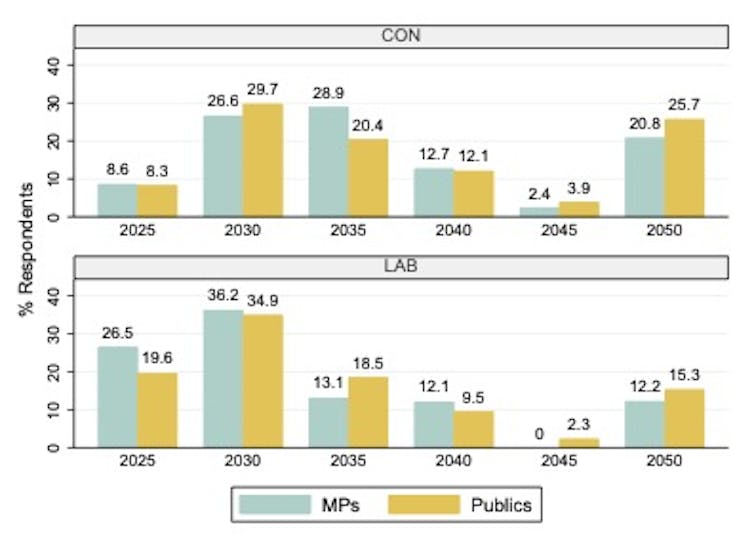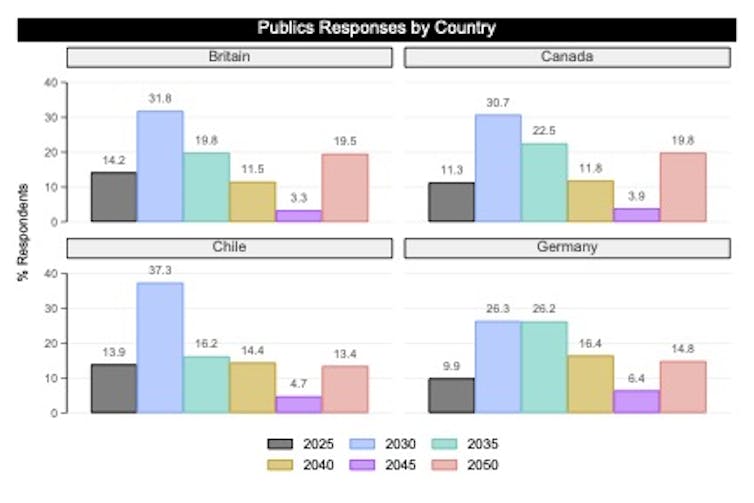Source: The Conversation – UK – By Anthony Ridge-Newman, Associate Dean And Associate Professor School of Humanities, Liverpool Hope University
In the wake of the 2024 general election, media headlines, public discourse, and Reform UK’s consistently favourable electoral and polling results have suggested the party poses an “existential threat” to the Conservatives.
The Conservatives have seen off and subsumed major threats in their long history. But Reform UK is a well-oiled machine. Its leader is a political juggernaut who has honed his skills in a new era of populist political communication and looks better connected to voters as a result. The contemporary Conservative party, meanwhile, is a deer caught in headlights.
The decline in the relevance of the Conservative party and the rising relevance of Reform UK as the de facto opposition party was demonstrated by Prime Minister Keir Starmer during his party conference speech when he placed primary importance on battling Farage and did not even mention Conservative leader, Kemi Badenoch, by name.
It is pertinent to note that the rise of Reform UK, formerly the Brexit party, is not an isolated phenomenon. Since Brexit entered our lexicon, scholars have observed political fragmentation and new divides appearing across the political spectrum.
Several nascent political entities have risen and declined, such as the fleetingly registered Change UK party. The European Research Group, a eurosceptic grouping of Tory MPs limps on, but with dramatically reduced influence and activity since the last election.
New political groupings continue to form on both the left and right of British politics. Despite some recent infighting, former Labour MPs Jeremy Corbyn and Zarah Sultana are starting a new party, currently known as Your Party.
But what seems comparatively different on the right is Reform’s fairly rapid, real and successive electoral successes. The outcome of Brexit in 2016 and Reform’s rise in the UK reflects similar recent trends across the world. Voters are turning away from conventional and centrist politics towards more disruptive forces. Trumpism in the United States might be the most notable example.
Historically, at times of significant cultural, technological and social change, we have observed seismic shifts in the political landscape. The most comparable example in the UK might even be the rise of the Labour party at the outset of the 20th century, which came at a time when the right of the British political system was undergoing upheaval.
Around that period, what we now know as the Conservative party was a parliamentary coalition undergoing a process of evolution. Various political groupings, including older Whigs and Tories, and newer Liberal Unionists and National Liberals, linked with Conservatives to form what formally became the Conservative and Unionist party.
Students of the Conservative party, such as historian Richard Cockett, argue the party is like a “Darwinian” organism. It has the ability to adapt and survive – and indeed has survived many crises. It survived the birth of Labour, having weathered a major split, almost a century prior to that, under the leadership of Sir Robert Peel over the repeal of the corn laws.
Many experts cite the Conservative party as the world’s most successful democratic political party in history. To describe Reform as an existential threat in this context is therefore all the more striking.
Reform continues to lack concrete plans in several key areas. Its annual conference primarily focused on immigration, without delivering policies on other pressing issues, such as housing and health. But unlike the Tories, Reform enjoys outsider credibility, further enhanced by Farage’s media-savviness. This clean-slate status allows Reform UK to tap into emotional and cultural discontent – a hallmark of populist politics.
Now, the Conservative party, which has historically absorbed or neutralised political threats, may face a challenge it cannot subsume. If Reform UK was to outperform the Tories at the next election, it would amount to a fundamental realignment of the right in British politics. It would raise the spectre of something that goes against conventional academic wisdom: that the Conservative party always adapts to survive.
Adapt or die
Reform UK’s success suggests it is not simply a fringe distraction, but a genuine existential threat to the political dominance and identity of the Conservative party. Its survival ultimately depends on its ability to evolve and adapt in this new political context.
Currently, the Conservative party seems lost in the wilderness. It is far too laboured in its thinking about how to reshape its identity in an era of superfast social, political and technological change.
It is failing to resist the urge to emulate aspects of the Reform UK agenda, and seems to be lurching further to the right towards its rival. In so doing, the Tories are losing their unique selling point.
The modern Conservative party has been at its strongest when it is able to show a combination of party unity and an image of competent leadership (echoing a sense that it is the party of good and prudent governance), all housed within a catchall and centrist offering. Lurching to the right simply plays into the hands of Reform UK – they risk losing more moderate supporters and splitting the harder right vote with Reform UK.
Want more politics coverage from academic experts? Every week, we bring you informed analysis of developments in government and fact check the claims being made.
Sign up for our weekly politics newsletter, delivered every Friday.
![]()
Anthony Ridge-Newman does not work for, consult, own shares in or receive funding from any company or organisation that would benefit from this article, and has disclosed no relevant affiliations beyond their academic appointment.
– ref. The Conservatives always adapt to survive – or do they? – https://theconversation.com/the-conservatives-always-adapt-to-survive-or-do-they-265255






